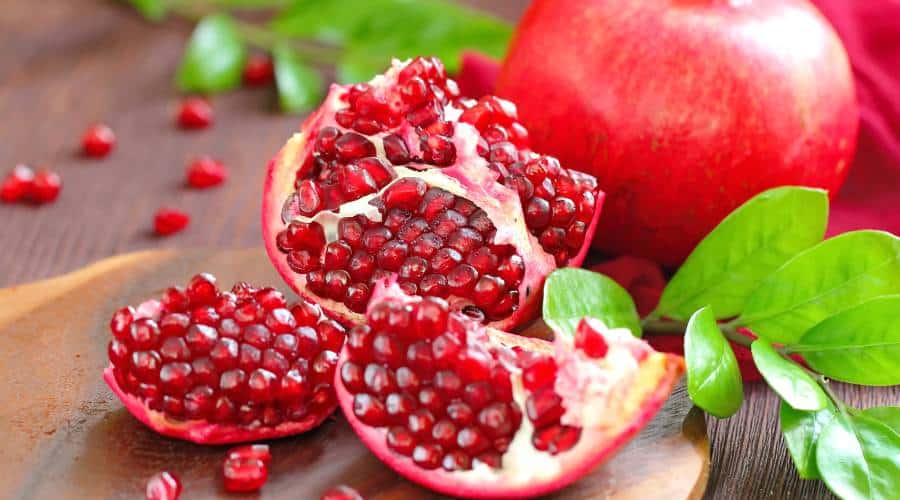Pomegranates, specifically their seeds (known as Arils), are a delicious and nutritious fruit, but they can be hard to come by out of season. If you’re lucky enough to have a tree or find them in bulk, you may be wondering how to preserve and store them for later use. The good news is that there are several ways to store pomegranates so that you can enjoy them all year round.
In this article, we’ll discuss 6 ways to preserve and store pomegranates long-term by refrigeration, freezing, canning, drying, juice concentrate, and freeze-drying. We’ll also explore the shelf life of the various types of preserved pomegranates to help you make the most of your storage.
As someone with experience preserving and storing pomegranates, I can attest to the fact that there’s nothing quite like popping a few juicy, fresh pomegranate arils (or seeds) in your mouth in the middle of winter. By following the methods outlined in this article, you’ll be able to enjoy that same experience even when pomegranates aren’t in season. So whether you’re a farmer, a home gardener, or just a pomegranate lover, read on to learn how to store pomegranates long-term.
Choosing the Right Pomegranates for Storage Preparation
I have always found that the first step to storing pomegranates is making sure to choose the right fruit. When it comes to taste and nutritional value, ripe and fresh pomegranates will yield the best results.
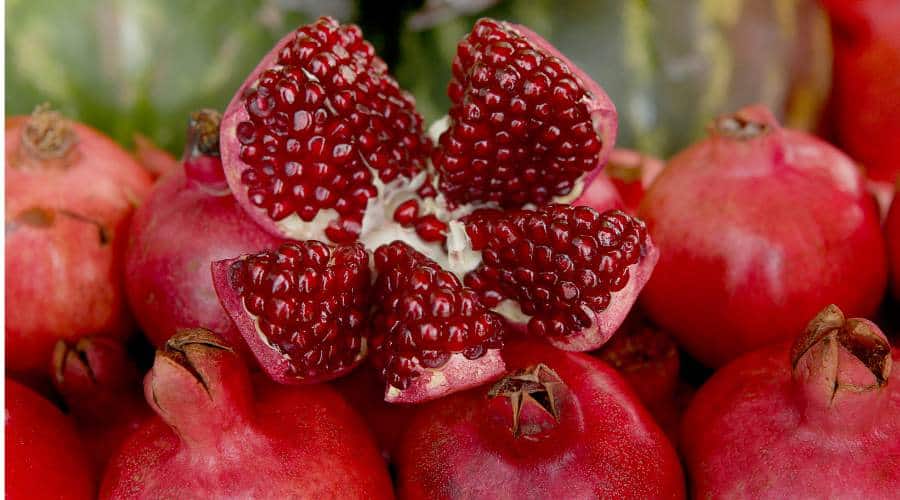
Here are a few tips for selecting the best pomegranates:
- Choose pomegranates that are heavy for their size. This is a sign that they are full of juice.
- Check for any soft spots or mold. These are signs that the pomegranate is overripe or spoiled.
- Give the pomegranate a gentle squeeze. If it feels firm and doesn’t give too much, it’s probably ripe.
- Avoid pomegranates that have a dull color. They should have a bright, shiny skin.
When you bring your pomegranates home, it’s important to store them in a cool place, such as a refrigerator, until you’re ready to preserve them. This will help to maintain their freshness and prolong their shelf life.
It’s worth considering that if you plan to preserve pomegranates in the form of juice, you can choose the pomegranates that are not as sweet. They will contain more juice and it will be less sweet when you preserve it, which can be beneficial for certain recipes.
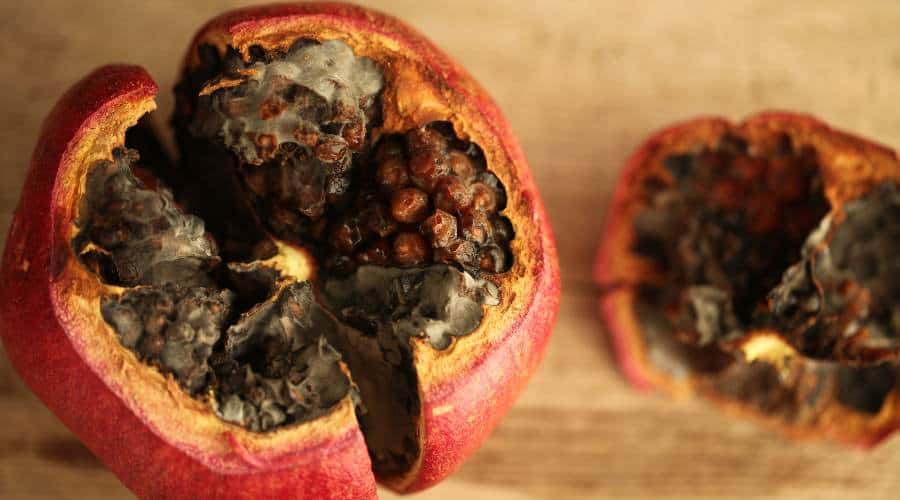
By following these tips, you’ll be able to select the best pomegranates for storing under the following conditions.
Preparing Pomegranates for Preservation and Storage
Once you’ve selected the best pomegranates, the next step is to prepare them for preservation and Storage. Proper preparation is crucial for maintaining the quality of the fruit and ensuring that it stays fresh for as long as possible.
Here are some tips for preparing pomegranates before storing them:
- Clean the pomegranates thoroughly. Use a brush or sponge to remove any dirt or debris from the skin.
- Cut away any damaged or moldy parts. These can cause the entire fruit to spoil.
- Dry the pomegranates completely. Any moisture on the surface of the fruit can lead to mold or bacteria growth.
- Remove the arils (seeds) from the fruit if you’re planning to preserve the pomegranate by juicing, freezing, drying, canning, or freeze-drying the arils.
It’s important to consider that some preservation methods like pickling or canning may require a bit more preparation like cutting the fruit into smaller pieces, but the steps above are a general guide for all preservation methods.
How to Remove the Seeds (Arils) From the Pomegranate
There may be several ways to remove the seeds from a pomegranate but here are two easy methods:
- The water method: Cut the pomegranate in half and place the halves in a bowl of water. Gently break the fruit apart and use your fingers to remove the arils. The arils will sink to the bottom of the bowl while the white membrane will float to the top. Skim the white membrane off the top of the water and strain the arils from the water.
- The bowl method: Cut the pomegranate in half and hold the pomegranate half over a bowl, cut side down. Using a wooden spoon or the back of a large spoon, whack the back of the pomegranate skin to release the arils into the bowl. Repeat with the other half of the pomegranate.
Both methods are effective and easy to do, you can choose the one that you find more comfortable for you. Whichever method you choose, be sure to wear an apron or old clothes as pomegranates can be messy to work with.
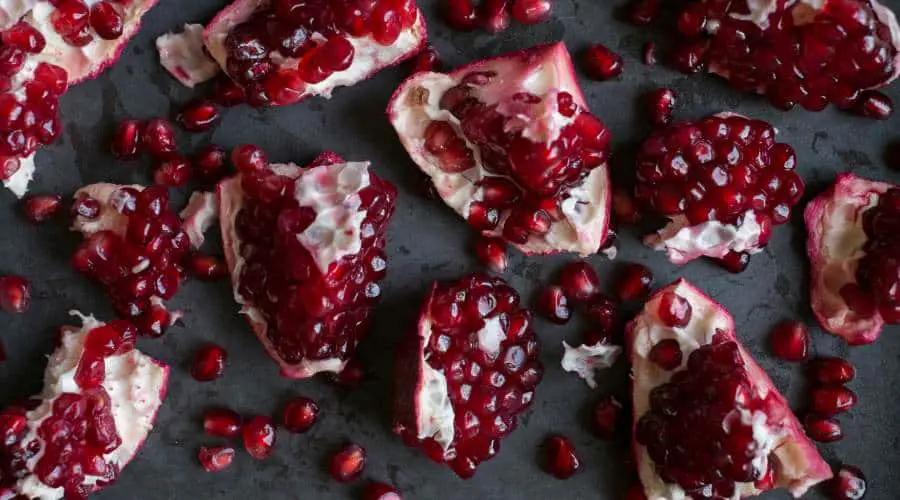
What you’ll need:
- Pomegranate
- Water
- Bowl
- Knife
- Apron or old cloths
Also, see complete guides on how to store these common types of food storage items:
Storing Pomegranates in the Refrigerator
One of the simplest ways to preserve pomegranates is by storing them in the refrigerator. This method is best for pomegranates that are ripe and fresh. Here are 3 simple steps on how to store pomegranates in the refrigerator:
- Place the pomegranates in a plastic bag or container. This will help to prevent them from drying out.
- Make sure the container or bag is airtight to prevent any moisture or air from getting in.
- Keep the pomegranates in the refrigerator’s crisper drawer, which is the coldest part of the refrigerator.
While refrigeration is a simple and convenient method of preservation, it’s important to note that refrigeration can cause the pomegranates to lose some of their texture and flavor over time.
When you are ready to use the refrigerated pomegranates, simply remove them from the refrigerator and allow them to come to room temperature before consuming. This will help to restore some of their flavor and texture.
How long do pomegranate seeds last in the fridge?
Pomegranate seeds, also known as arils, can last up to 2 months in the refrigerator if stored in an airtight container or resealable bag. To prolong the shelf life of pomegranate seeds, it is also important to ensure that the container or bag is moisture-free, as excess moisture can cause the arils to spoil faster.
It’s important to note that over time, the texture and flavor of the pomegranate seeds may change, so it’s best to consume them within 2 months of storing them in the fridge.
Storing Pomegranates in the Freezer
Another way that I have had great success storing my pomegranates for the long term is by freezing them. This method is best for pomegranates that are already ripe.
Here are 4 simple steps to store pomegranates in the freezer:
- Remove the seeds (arils) from the pomegranate which will make them easier to use and consume later.
- Spread the arils on a baking sheet or plate in a single layer and place them in the freezer.
- After the arils are frozen, transfer them to an airtight container or resealable bag.
- Label the container or bag with the date, and store them in the freezer.
Freezing is a great way to preserve pomegranates because it preserves the flavor and texture of the fruit. The arils will maintain their shape, and can be easily added to recipes or enjoyed as a snack.
When you’re ready to use the frozen pomegranate seeds, simply remove them from the freezer and allow them to thaw at room temperature. They can be used as fresh arils in salads, smoothies or as a topping for yogurt or cereal.
What you’ll need:
- Pomegranate seeds
- Freezer
- Baking sheet or plate
- Airtight container or vacuum-sealed bag (see if a vacuum sealer is worth it for you)
- Marker to date the bag
What is the Shelf Life of Pomegranates that are Stored in the Freezer?
Pomegranate seeds (or arils) that have been packaged in an airtight container can be stored in the freezer for up to 6-8 months while maintaining their taste and quality. However, if the pomegranates were frozen whole, they will only last for about 3-4 months.
It’s important to note that even though frozen pomegranates can last for several months, their quality will start to decline over time. Frozen pomegranates may lose some of their texture and flavor and may not be as good as when they were first frozen.
Canning Pomegranates
Canning is another way to preserve pomegranates and it’s best used for preserving pomegranate juice, jelly, or jam. Canning is a great way to enjoy the sweet and tangy flavor of pomegranates all year round.
Here’s how to can pomegranates:
- Start by sterilizing your jars, lids, and rings. This can be done by boiling them for 10 minutes.
- Press the pomegranates to extract the juice. You can use a juicer or press the fruit by hand.
- Prepare the canning recipe of your choice, whether it’s jelly, jam or just preserving the juice.
- Pour the prepared recipe into the sterilized jars and leave about 1/4-inch headspace.
- Wipe the rims of the jars clean, and then place the lids and rings on the jars.
- Process the jars in a water bath canner for the recommended time for your recipe (see a recipe by USU).
- Once the jars have cooled, check the seals. If the lid pops back when you press on it, the jar is not sealed and the canning process did not work.
Canning is a preservation method that requires some experience and knowledge of the process (see details by NCHFP), but it’s a great way to preserve pomegranates for a longer period of time. It allows you to enjoy the sweet and tangy flavor of pomegranates in the form of juice, jelly, or jam throughout the year.
How to Store Canned Pomegranates
Once canned, pomegranate juice, jelly, or jam should be stored in a cool, dark, and dry place, such as a pantry or cupboard. It’s important to keep them away from heat sources, direct sunlight, and moisture. Proper storage will help to preserve the quality and prolong the shelf life of the canned pomegranates.
Here are a few tips for storing canned pomegranate juice, jelly, or jam:
- Make sure the jars are properly sealed. A properly sealed jar will have a “pop” sound when the lid is pressed down. If the lid pops back when you press on it, the jar is not sealed and should be refrigerated.
- Store the jars in a cool, dark place, such as a pantry or cupboard. Avoid storing them in a damp or humid area.
- Label the jars with the date they were canned and the type of product inside.
- Keep the jars in a single layer, away from other heavy objects, to prevent damage.
It’s important to check the jars periodically for any signs of spoilage, such as mold or off-odors. If you notice any spoilage, discard the contents of the jar and clean the jar thoroughly before using it again.
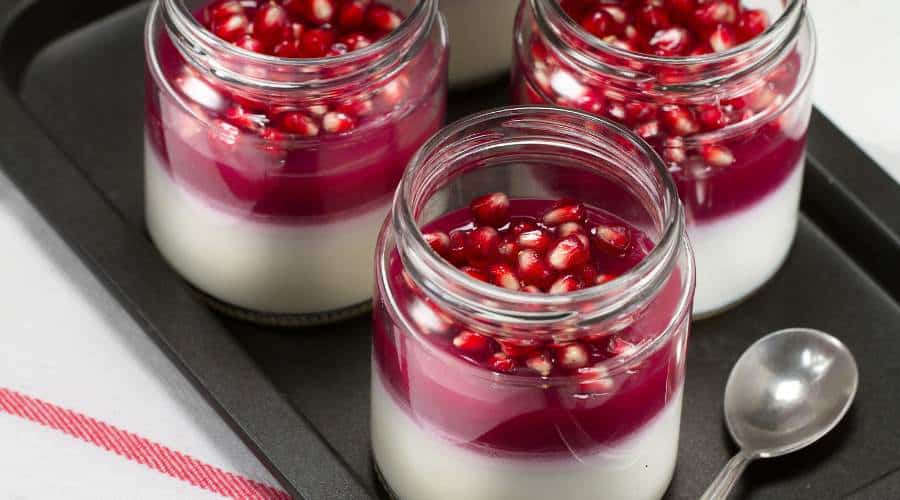
Drying (Dehydrating) Pomegranates
Drying is another way to preserve pomegranate seeds (arils). We have found that drying the arils allows you to enjoy the sweet and tangy flavor of pomegranates all year round and it’s a great way to add some crunch to your snacks or meals.
Here’s how to dry pomegranate arils:
- Start by removing the arils from the pomegranate.
- Spread the arils on a baking sheet or plate in a single layer.
- Place the baking sheet or plate in a dehydrator set to 135°F or in an oven on the lowest setting with the door slightly open.
- Dry the arils for 6-8 hours in the dehydrator or 8-12 hours in the oven, or until they are dry and leathery.
- Once dry, store the arils in an airtight container or resealable bag and keep in a cool, dry place.
Drying the arils is a great way to preserve them for a longer period of time. Dried arils can be used as a snack or as a topping for yogurt, cereal, or salad. See what else you can dehydrate.
When you’re ready to use the dried pomegranate arils, simply rehydrate them by soaking them in warm water for about 10 minutes. They can be used as fresh arils in salads, smoothies, or as a topping for yogurt or cereal.
What you’ll need:
- Pomegranate seeds
- Dehydrator (see best dehydrators)
- Airtight container, vacuum-sealed bag, or mylar bag
- Marker to date the bag
How to Store Dried Pomegranate Seeds (Arils)
When storing dried (dehydrated) pomegranate seeds, it’s important to keep them in a cool, dry, and dark place to maintain their quality and prolong their shelf life. Here are a few tips for storing dried pomegranate seeds:
- Store the dried arils in an airtight container or resealable bag such as a vacuum-sealed bag or mylar pouch with oxygen absorbers. This will help to keep out moisture and light, which can cause the arils to spoil.
- Keep the container or bag in a cool, dry place, such as a pantry or cupboard. Avoid storing them in a damp or humid area.
- Label the container or bag with the date they were dried.
- Keep the container or bag in a single layer, away from other heavy objects, to prevent damage.
It’s important to check the container or bag periodically for any signs of spoilage, such as mold or off-odors. If you notice any spoilage, discard the contents and clean the container thoroughly before using it again.
Storing Pomegranate Juice Concentrate
Another way to preserve pomegranates is by making pomegranate juice concentrate. We have enjoyed using it to add some natural sweetening to our drinks and other recipes.
Here’s how to make pomegranate juice concentrate:
- Start by removing the arils from the pomegranate and press them to extract the juice.
- Boil the juice in a large pot over medium-high heat, stirring occasionally, until it reduces by about half.
- Once reduced, strain the juice through a fine-mesh strainer to remove any solids.
- Pour the juice into an airtight container or bottle and store it in the refrigerator or freezer. If you freeze it make sure to leave some headspace in the container for when it expands during freezing.
Pomegranate juice concentrate can be used to make pomegranate drinks, or it can be added to sauces, marinades, or dressings for a burst of flavor. You can also mix it with water or other juice to make a refreshing drink.
When you’re ready to use the concentrate, simply take it out of the refrigerator and dilute it to the desired strength. Pomegranate juice concentrate can be stored in the refrigerator for up to 3 months or for up to 6-8 months in the freezer.
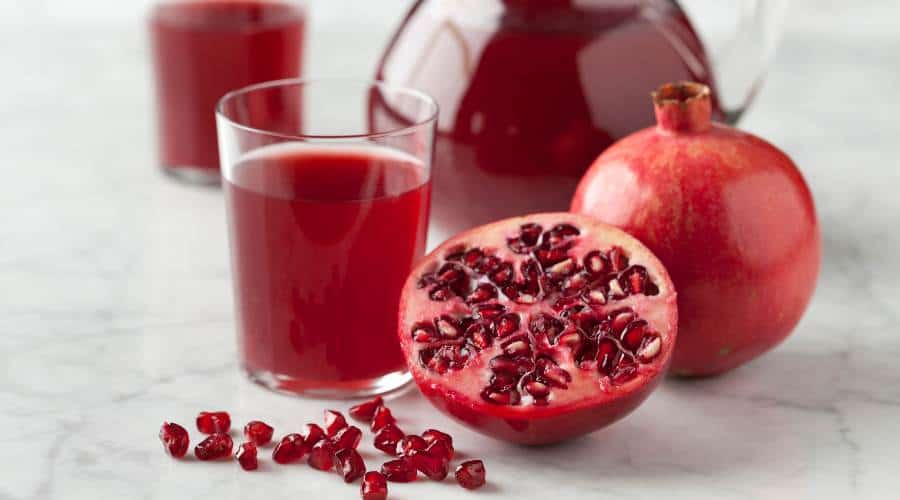
Storing Freeze Dried Pomegranates
We own a home freeze dryer and love using it (see if owning a home freeze dryer is worth it for you). If you can, we recommend freeze-drying your own pomegranate arils (seeds). Make sure to use arils that are already ripe.
Here’s how to freeze-dry and store pomegranates:
- Start by removing the seeds (arils) from the pomegranate.
- Spread the arils on a baking sheet or plate in a single layer.
- Place the baking sheet or plate in a freeze dryer.
- Freeze dry the arils for 24-48 hours or until they are fully dehydrated.
- Once dry, store the arils in an airtight container or resealable bag and keep them in a cool, dry place.
Freeze drying is a preservation method that removes the moisture from the pomegranate arils, this way they will maintain their texture and flavor for a longer period of time than regular drying. Freeze-dried pomegranate arils can be used as a snack or as a topping for yogurt, cereal, or salad. See what else you can freeze dry.
When you’re ready to use the freeze-dried pomegranate seeds, simply rehydrate them by soaking them in warm water for about 10 minutes. They can be used as fresh arils in salads, smoothies or as a topping for yogurt or cereal.
What you’ll need:
- Pomegranate seeds
- Freeze dryer with trays
- Airtight container, vacuum-sealed bag, or mylar bag
- Marker to date the bag
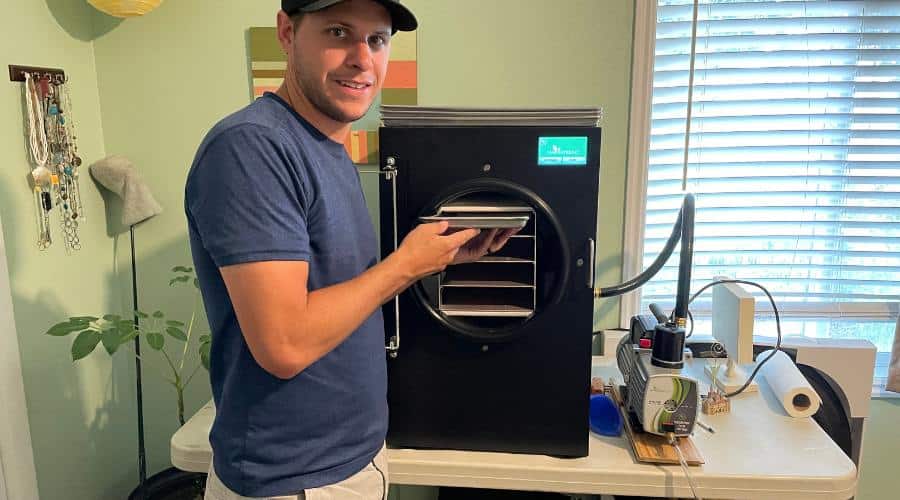
Before storing pomegranates or other foods consider the factors that affect the shelf life of food.
Conclusion
Pomegranates are a delicious and nutritious fruit that can be enjoyed all year round. Whether you’re looking to preserve them for a few weeks or several months, there are many different methods to choose from.
By following the tips and techniques outlined in this article, you’ll be able to select, prepare, and store pomegranates in the best possible condition. Whether you choose to refrigerate, freeze, can, dry, or freeze-dry them, you’ll be able to enjoy their delicious flavor and nutritional benefits all year long.
In summary, the different ways to preserve and store pomegranates are: refrigeration, freezing, canning, freeze drying, dehydrating, and juicing. Each method has its own advantages and disadvantages, and it’s up to you to choose the one that best suits your needs and preferences.
By preserving and storing pomegranates, you’ll be able to enjoy their delicious flavor and nutritional benefits all year round, and you’ll have a variety of options to use them in recipes. So, go ahead, give it a try, preserve and store some pomegranates today!

